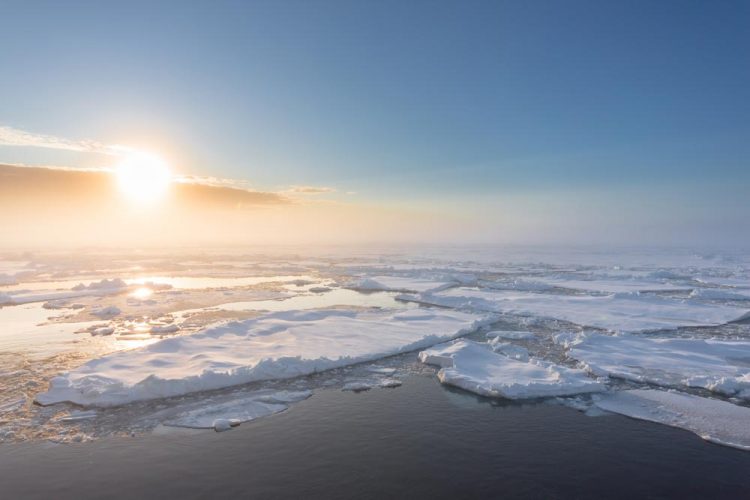How the Arctic Ocean Became Saline

Drift ice and pack ice seen from aboard the German research vessel Polarstern, on the way to the North Pole. (Foto: Stefan Hendricks)
The Arctic Ocean was once a gigantic freshwater lake. Only after the land bridge between Greenland and Scotland had submerged far enough did vast quantities of salt water pour in from the Atlantic. With the help of a climate model, researchers from the Alfred Wegener Institute have demonstrated how this process took place, allowing us for the first time to understand more accurately how Atlantic circulation, as we know it today came about. The results of the study have now been published in the journal Nature Communications.
Every year, ca. 3,300 cubic kilometres of fresh water flows into the Arctic Ocean. This is equivalent to ten percent of the total volume of water that all the world’s rivers transport to the oceans per year. In the warm and humid climate of the Eocene (ca. 56 to 34 million years ago), the inflow of freshwater was probably even greater.
However, in contrast to today, during that geological period there was no exchange of water with other oceans. The influx of saline Atlantic and Pacific water, which today finds its way into the Arctic Ocean from the Pacific via the Bering Strait and from the North Atlantic via the Greenland-Scotland Ridge, wasn’t possible – the region that is today completely submerged was above the sea at that time.
Only once the land bridge between Greenland and Scotland disappeared did the first ocean passages emerge, connecting the Arctic with the North Atlantic and making water exchange possible. Using a climate model, researchers from the Alfred Wegener Institute, Helmholtz Centre for Polar and Marine Research (AWI) have now successfully simulated the effect of this geological transformation on the climate.
In their simulations, they gradually submerged the land bridge to a depth of 200 metres. “In reality, this tectonic submersion process lasted several million years,” says Climate Scientist Michael Stärz, first author of the study. “Interestingly, the greatest changes in the circulation patterns and characteristics of the of the Arctic Ocean only occurred when the land bridge had reached a depth of over 50 metres below the surface.”
This threshold depth corresponds to the depth of the surface mixed layer, and determines where the relatively light Arctic surface water ends and the underlying layer of inflowing North Atlantic water begins. “Only when the oceanic ridge lies below the surface mixed layer can the heavier saline water of the North Atlantic flow into the Arctic with relatively little hindrance,” explains Stärz.
“Once the ocean passage between Greenland and Scotland had reached this critical depth, the saline Arctic Ocean as we know it today was created.” The formation of ocean passages plays a vital role in global climate history, as it leads to changes in heat transport in the ocean between the middle and polar latitudes.
The theory that the Arctic Basin was once isolated is supported by the discovery of freshwater algae fossils in Eocene deep-sea sediments that have been obtained during international drilling near the North Pole in 2004. What was once a land bridge now lies ca. 500 metres under the ocean and consists almost entirely of volcanic basalt. Iceland is the only section remaining above the surface.
Notes for Editors
Original publication in Nature Communications:
Michael Stärz, Wilfried Jokat, Gregor Knorr, Gerrit Lohmann: „Threshold in North Atlantic-Arctic Ocean circulation controlled by the subsidence of the Greenland-Scotland Ridge“ DOI: 10.1038/ncomms15681.
Printable images are available at: https://www.awi.de/nc/en/about-us/service/press/press-release/wie-der-arktische-…
Your contact person at the Dept. of Communications and Media Relations is Sebastian Grote, tel. +49 (0) 471 4831-2006 (e-mail: sebastian.grote(at)awi.de).
Your scientific contact person is Dr Gregor Knorr, tel. +49 (0) 471 4831-1769 (e-mail: gregor.knorr(at)awi.de).
The Alfred Wegener Institute, Helmholtz Centre for Polar and Marine Research (AWI) conducts research in the Arctic, Antarctic and oceans of the high and mid-latitudes. It coordinates polar research in Germany and provides major infrastructure to the international scientific community, such as the research icebreaker Polarstern and stations in the Arctic and Antarctica. The Alfred Wegener Institute is one of the 18 research centres of the Helmholtz Association, the largest scientific organisation in Germany.
Media Contact
More Information:
http://www.awi.de/All latest news from the category: Earth Sciences
Earth Sciences (also referred to as Geosciences), which deals with basic issues surrounding our planet, plays a vital role in the area of energy and raw materials supply.
Earth Sciences comprises subjects such as geology, geography, geological informatics, paleontology, mineralogy, petrography, crystallography, geophysics, geodesy, glaciology, cartography, photogrammetry, meteorology and seismology, early-warning systems, earthquake research and polar research.
Newest articles

A ‘language’ for ML models to predict nanopore properties
A large number of 2D materials like graphene can have nanopores – small holes formed by missing atoms through which foreign substances can pass. The properties of these nanopores dictate many…

Clinically validated, wearable ultrasound patch
… for continuous blood pressure monitoring. A team of researchers at the University of California San Diego has developed a new and improved wearable ultrasound patch for continuous and noninvasive…

A new puzzle piece for string theory research
Dr. Ksenia Fedosova from the Cluster of Excellence Mathematics Münster, along with an international research team, has proven a conjecture in string theory that physicists had proposed regarding certain equations….



